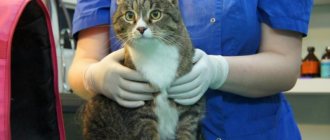Experts do not recommend sterilizing a pregnant cat; this is only permitted as a last resort. When the owners miss the moment and the pet manages to become pregnant, it is better for her to carry to term and give birth to babies. But initially you should make sure that the kittens will be settled.
If the doctor decides that sterilization is possible, then they do not perform a regular operation, but the so-called “extirpation of the pregnant uterus,” in which the veterinarian makes an incision in the abdomen and from there removes the ovaries and uterus with embryos.
Read the article about what cat sterilization is.
In any case, before making a decision, you should consult your veterinarian about whether a pregnant cat can be sterilized.
Mr. Cat Explains: Principles of Operation
Removing embryos from the uterus during the sterilization process is quite difficult. This is due to some distinctive features of the structure of the cat’s reproductive system. Due to the significant extent of the bicornuate uterus, during pregnancy it can accommodate several fetuses at once.
Even a highly qualified veterinarian is not able to remove future kittens from the uterus without damaging its walls. For this reason, sterilization is performed, in which the doctor makes an incision in the abdominal area to remove and eliminate the ovaries and uterus with developing embryos. This surgical intervention is called “extirpation of the pregnant uterus”; it is more risky compared to simple sterilization.
What are the risks of sterilizing a pregnant cat?
Surgical intervention for pets is dangerous due to the following:
- The pregnant uterus of increased size is penetrated by the circulatory system.
- During surgery, the cat experiences an increase in blood loss, and the postoperative scar due to the enlarged uterus will be larger than with planned castration.
- Rehabilitation will also take longer than after a simple operation, since the body of a pregnant animal will endure serious physical and hormonal stress.
If there is a need to sterilize a pregnant cat, it is better to do it early. Because in the later stages it is risky not only for the pet’s health, but also for its life.
If there are suspicions about pregnancy, it is recommended to conduct an ultrasound examination 14 days after the animal’s sexual intercourse. If suspicions of conception are confirmed, it would be wise to immediately sterilize the cat. In such a situation, the cat will practically not suffer, and the possibility of developing negative consequences will be minimal. The most optimal time for the operation is a maximum of 6 weeks of pregnancy. Read the article about the first birth of a cat.
Postoperative care
What he really is? Immediately after the operation, it is extremely important that the owner takes care of the safety of his pet. While under anesthesia, the animal cannot control its movements. Therefore, a cat after anesthesia after sterilization should be under constant supervision during the first 24 hours. To transport the animal, you must use a special carrier. During recovery from anesthesia, the pulse and breathing will remain slow. Temperatures will also be significantly reduced. Therefore, there is a high risk of cat hypothermia. If the operation is carried out in the cold season, it is recommended to additionally cover the cat with a warm blanket or put on a heating pad.
Another danger that an animal in a state of narcotic sleep may encounter is inflammation of the cornea of the eye. The fact is that under anesthesia, cats’ vision organs do not close. To prevent an inflammatory process from occurring after the operation, it is necessary to close and open the eyelids several times over the course of an hour. When the animal comes out of anesthesia, it can be offered a small amount of water. The thirst can be quite strong. The cat will need to be given the first portion of food only a few hours after the operation. However, as a rule, the animal has no appetite. This is fine.
The best place for sterilization
It is recommended to sterilize a pregnant cat at a veterinary hospital. If you decide to sterilize your animal, it is important to minimize stress on the cat.
Some owners make arrangements with the veterinarian to perform the operation at home. But, given the possible negative consequences, it is better to sterilize such an animal in a hospital setting:
- In the clinic, if a critical situation arises, specialized medical equipment will be connected, which the doctor cannot use when operating at home.
- At the veterinary hospital, the pet can be left for the first time under the supervision of a doctor.
- At the clinic, your pet will be provided with the necessary post-operative care and professionally performed procedures.
Stages of the procedure
Castration in cats is a serious abdominal operation performed under general anesthesia. The steps of the operation include:
- Mandatory preparation, vaccination is required (according to plan), as well as antiparasitic complex treatment against helminths and ectoparasites. Before the scheduled day of surgery, it is recommended to keep the cat on a fasting diet for at least 10 hours.
- Preparing a pet for a planned operation in a veterinary clinic includes an examination and taking the necessary blood and urine tests. If there are possible deviations, the doctor will not be able to perform surgery. Next, the animal is weighed to determine the exact dose of the drug. The animal, which is in a deep stage of sleep, is placed on the operating table. The fur is removed from the intended incision site and treated with antiseptic solutions.
- Carrying out the operation. The surgeon creates access by cutting through the abdominal tissue. When carrying out planned sterilization of a non-pregnant cat, tissue dissection is carried out from the side. A larger incision is required to remove the uterus and fetuses. Ligatures are applied to compress large vessels that fill the uterus with blood. This will prevent serious bleeding. Next, the uterus and appendages are removed and special sutures are applied.
The operation begins with the administration of anesthesia
Sterilizing a pregnant cat: inevitability and ideal age
A cat's heat begins at an early age, sometimes after reaching 6 months. However, it is impossible to sterilize a pet before 8 months, since the body, which is not fully formed, suffers severe stress because of this. When surgery is performed at an early age, there may be a delay in the formation of the kitten.
In addition, it is prohibited to sterilize a cat that weighs less than 2.5 kilograms (with the exception of features provided for by the breed).
It is allowed to sterilize an animal upon reaching one year of age and at a later time. Although the owner should not delay surgical intervention due to the risk of disease formation. Hormonal drugs that suppress estrus can cause some negative consequences, including serious hormonal and psychological disorders, cancer in the uterus or ovaries.
It is ideal to sterilize a cat at 7-9 months of age.
If there is no desire to deal with the placement of kittens several times during the year, it is recommended to operate on the pet, especially when it walks on the street or often runs away from home. Cats have high sexual activity, which contributes to the onset of another pregnancy even when feeding babies.
Causes
A domestic cat and its health will be maximally protected if the owner treats the animal responsibly and regularly shows it to the veterinarian, especially during pregnancy. Animals may also experience various problems throughout the months of gestation.
Their timely detection will allow you to quickly and effectively solve the problem, save the health and even the life of your beloved pet. Extirpation of the pregnant uterus has a number of features that experienced veterinarians know about:
- During pregnancy, the uterus increases in size and is permeated with vessels.
- This increases the risk of bleeding during surgery.
- The postoperative scar will be large.
- The owner needs to show maximum attention to his cat during the period of its rehabilitation and recovery, because surgical intervention in this situation is quite serious.
The shorter the pregnancy, the less complications you can expect from the operation. When the owner of a domestic cat is attentive and watches her regularly, he will know when a meeting with a male and sexual intercourse could take place.
In this case, it is worth bringing your pet to the clinic in two weeks, where they will conduct an examination and determine the fact of pregnancy. At an early stage, sterilization will occur with minimal risks, and the animal will recover quickly.
ATTENTION! The deadline for sterilization is the sixth week of pregnancy.
Specifics of surgical intervention
A pregnant cat can be sterilized early or late in pregnancy. The specifics of the operation remain unchanged - the veterinarian removes the uterus and ovaries. However, the longer the period, the more difficult the surgical intervention will be. In such a situation, not simple sterilization is performed, but ovariohysterectomy or castration.
The process involves removing the ovaries and uterus at the same time. Experts give preference to ridding the animal of the entire reproductive system, since tumors or other diseases may begin to develop due to the abandonment of the uterus.
Any surgical intervention is performed under general anesthesia in a veterinary hospital. Conventional sterilization is carried out using a seamless method, the final incision in such a situation is approximately 1 cm in length, but this is not suitable for a pet in this position. She will need long-term rehabilitation - the scar takes a long time to heal - and doctors will have to worry about possible bleeding. Babies, even in later stages, usually die.
Sterilizing a cat during pregnancy is more dangerous than undergoing simple surgery. At a later date, the likelihood of negative consequences increases.
As a result, veterinarians advise operating on the pet before the pregnancy reaches one month.
Under the influence of developing embryos, the uterus expands and they require more blood supply. Therefore, during surgery, an increase in blood loss is observed. Due to the increase in size of the uterus, the postoperative scar is very large.
In addition, at a later stage the body prepares for feeding kittens, this contributes to the occurrence of complications that will have to be encountered during the operation. In addition, the development of hormonal stress is observed. Because of these factors, the risk of developing negative consequences increases, namely, bleeding and inflammation in the scar area.
Also read articles about blood and other discharge in a pregnant cat.
Is it possible to sterilize a cat during pregnancy?
The ideal solution for ending pregnancy is strong, healthy offspring that can be successfully placed with new owners. In this case, natural childbirth, further caring for your children until a certain period and a gentle parting with them as adults are the best outcome of resolving the issue. But it doesn't always work out that way. In many cases, a Murka can have 6 or more kittens; it can be unrealistic to accommodate such a number.
Of course, termination of pregnancy is a rather dangerous procedure, however, some pets need it in the following cases:
- the cat is many years old and pregnancy can only harm it;
- during pregnancy she experiences a noticeable deterioration in her health;
- the photographs taken by veterinarians show the underdevelopment of the embryo and some pathologies in its development;
- an emerging infection that must be immediately treated with heavy medications;
- care of the expectant mother for her existing young offspring.
However, owners who decide to sterilize their cat also receive advantages after this procedure:
- The cat will stop bothering household members with purring and other annoying behavior due to the absence of heat.
- The issue of uncontrolled birth of kittens is being resolved. There will still be fewer homeless animals, although this contribution is a drop in the ocean.
- By controlling the birth rate, owners also control the risk of their pets contracting infectious diseases from stray cats.
Care and care after surgery
Animals sterilized during pregnancy require special care afterward to prevent possible complications. After rehabilitation, the pet, as a rule, becomes calmer and more affectionate, and the aggressiveness that appeared due to hormonal changes during sexual arousal disappears.
Immediately after surgery, the cat should be placed in a warm, dark, and soft place until the anesthesia wears off.
Recovery is quite painful; therefore, while the animal is recovering, you should not contact it. This is especially true for disturbances from children and other pets.
During the rehabilitation process, the owner must take care of the condition of the scar, make sure that it does not get wet or fester, that it is dry and clean. Typically, a postoperative scar heals in 7-10 days.
In addition, during the recovery process the cat is prescribed antibiotics and vitamin preparations. You should also wipe your pet's eyes with contact lens solution so that they open normally after using anesthesia.
Special clothing can be used so that the post-operative suture heals faster and the scarring process proceeds as expected.
We recommend reading the article about food for sterilized cats.
Sterilizing a pet means taking care of it
Sterilizing a cat in any condition means responsibly keeping your pet.
Cats are characterized by rapid and fruitful reproduction. In the case where the owner does not breed purebred kittens, it is necessary, casting aside doubts, to carry out sterilization.
A domestic cat can acquire an infectious disease through contact with stray animals. Thanks to birth control, the number of stray cats is reduced and the risk of infection of a pet is reduced.
Stages of surgery during pregnancy
Castration in cats is an extremely important manipulation and much more difficult than castration in cats. The fact is that sterilizing cats involves a strip operation under general anesthesia.











